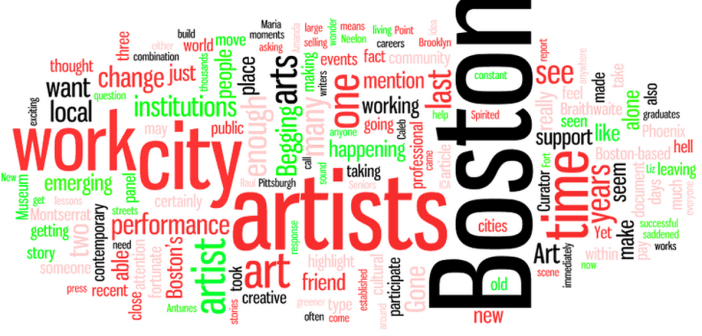Nine years later, the Boston Globe and Phoenix, stand emaciated by recession and a new media ecosystem dominated by the internet while the Herald is no longer even worth mentioning. Boston’s three biggest print publications couldn’t keep up with the art being made and exhibited here in the early naughts, yet now the city’s population, economy, and number of students are all bigger, and there has been an explosion of space erected and designated only for the exhibition of contemporary art.
In a January article, Globe art critic Cate McQuaid aptly described an art community as ecosystem. "Galleries are part of a larger ecosystem that includes museums, collectors, art schools, alternative spaces, and nonprofits… as well as the local community of artists, and critics. In a thriving system, the schools feed the alternative spaces, which feed the commercial galleries, on up to the museums." (emphasis mine)
Globe critics, however, rarely set foot inside student-run and alternative spaces. We know their publication doesn’t have the resources to cover every instance of cultural production in Boston, but we can and should criticize them about the diversity of the subjects of their reviews. McQuaid rarely covers contemporary art outside of Boston’s commercial galleries and her colleague Sebastian Smee, Boston’s only full-time art critic, rarely writes about anything but museums.
If emerging artists, emerging galleries and alternative arts spaces are part of the ecology of Boston’s arts community, then their output is no less deserving of coverage and critique than the city’s well established galleries and museums. Every year thousands of art students leave Boston and take with them the energy and creativity that keep arts communities thriving. They are emerging artists and need the recognition that a healthy art ecosystem should be able to provide them through its critics.
An outdated and pessimistic Phoenix article festooned with the cynical headline "Gone Begging" recently sought to explain why many young artists leave Boston. In an emotional yet clinical rebuttal to the piece, Montserrat Galleries Assistant Curator of Education Maggie Cavallo struck at a big root of the problem, and she received a number of responses. "The only thing that can change," musician Eric Zinman wrote in the comment section of Cavallo's piece, "…is the communication between artists, the awareness of who is doing what from the oldest to the youngest in all the mediums, spaces and venues"
"[T]he solution is not a larger number of younger smarter more productive artists but more connection and real intellectual exchange and leadership," he wrote.
Cavallo's piece echoed the youthful Nash and Horton as they met in the halls of the School of the Museum of Fine Arts a decade ago. Art journalism and criticism facilitates the emergence of new ideas, and some of those ideas become more art while others may even become exhibitions. Well-reviewed artists and curators are encouraged to make more work while the recipients of negative criticism start over and make new work — or are emboldened to create new projects that refute their critics. With recognition from publications like Big Red & Shiny, artists get into more exhibitions, receive commissions and grants, sell their work — which is now in higher demand thanks to all the discussions generated from BR&S coverage — and eventually those artists make it into the collections of museums — and are subsequently reviewed again, this time in BR&S V. 2.0.
We don’t always get everything right, but we know that artists and their art can’t exist in a vacuum. This is why we write.
CORRECTION: Nov. 19: The initial post of this article attributed Zinman's quotes to Cavallo.



